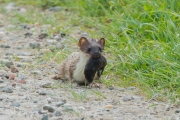Nature photography is often a matter of patience. Waiting at a spot where that one particular bird regularly returns. Or scout an area because a species has shown up there. But sometimes it’s also a matter of luck. Recently I was lucky. I was in the vicinity of the Oostpolder, a beautiful nature area at the border of the provences Groningen and Drenthe, where the white-tailed eagle (Haliaeetus albicilla) breeds, among other species. There was a rare squacco heron (Ardeola ralloides) seen over there, which I wanted to see. The bird was still there but far away. In June 2016 I had already seen and photographed this heron-like bird. Now he was much further away, so no nice pictures this time. But I could take a good glimpse of it through the telescope.
With or without black tailtip
On the way back I drove slowly over the gravel road to avoid literally blowing up too much dust. And of course, to look if there was something nice to be seen in the field. At one point I saw a car standing on the road at an angle and a large telephoto lens stuck out of the window. So there had to be something interesting. And yes, on the left side of the roadside I saw something small scurrying around: a weasel (Mustela nivalis) or a stoat (Mustela erminea)!
So I also put my car diagonally on the path and my telephoto lens as good as it gets through the open window. The little creature had something in its mouth and dragged it along as it hastily crossed the path. I made as many photos as possible. And I clearly saw his black tail tip, so definitely a stoat. On the other side of the path it stopped for a moment to continue its way along the roadside in my direction.
Young stoat or a prey?
Every now and then it stopped, watching me anxiously. And before I knew it disappeared into the high grass. A wonderful meeting with a few beautiful photos as a result. That evening I placed a photo in a Facebook group for the determination of plants and animals. With the question if someone could determine what the stoat had in its mouth. I first assumed a prey, but one of the reactions was that it could also be a young stoat. After all, weasels and stoats have the habit of occasionally moving their young.
I saw that once on Springwatch from the BBC. The mother animal transferred the cubs one by one to their new home. But if they pick up a cub, it would be much further towards the neck in front of the shoulder blades, like a feline would do. This little creature bit the animal behind the shoulder blades, which strengthened the suspicion of prey. After a day of discussion on Facebook, the result tended towards a young water vole (Arvicola amphibius).
It’s a pity about this little water vole, but I am a bit luckier and more experienced than before.
This post was originally published in Dutch on May 13th 2018.







